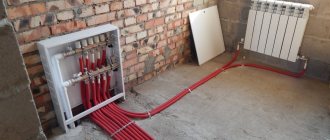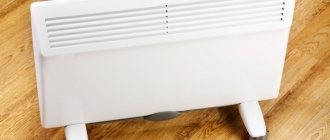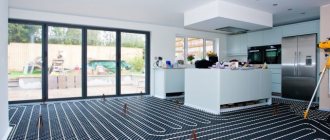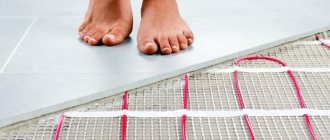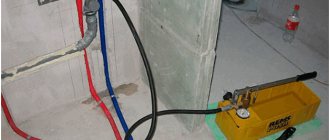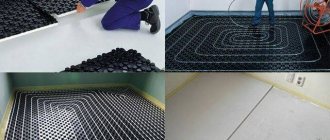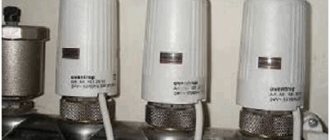Many people are interested in the question of what is better, conventional batteries or a warm water floor, let's try to figure it out. It is comfortable for a person when his feet are warm and his head is cold, but ordinary radiators cannot provide this.
In addition, when they are heated to a high temperature, you can get burned on the radiators , which is especially dangerous when there are small children in the house. The only advantage of such heating is its low cost and ease of installation.
The main disadvantage of heating radiators is uneven heating of the room and unnatural heat distribution.
If heating is carried out using a heated floor, then favorable conditions are created in the room, since the heat is evenly distributed and goes from bottom to top.
To prevent heat from going down, heat-reflecting materials must be used when laying pipes . A warm floor has a much larger surface area compared to radiators, so heating is carried out more efficiently and heat is distributed evenly.
The main advantages and disadvantages of both types of heating:
- Which is more economical? This is a very important indicator and in this matter, warm floors are more profitable. If we compare the two types of heating, then when heating apartments with heated floors, it is possible to save up to 20% of energy compared to using radiators.
- Cost of materials . In this case, much depends on the volume of the heating system, the materials and equipment used, whether you will do the work yourself or invite specialists. In any case, installing heated floors will cost more.
- Which heating is repairable ? In this case, the batteries win, since they can be easily and quickly removed, cleaned, or replaced. A warm water floor is laid in a concrete screed and if everything is done correctly, then it is done forever.
- Room heating rate . If batteries are installed, you can very quickly raise the temperature in the room. In the case of a warm water floor, the temperature will rise more slowly, but it will also take longer to cool down.
- Interior. Be sure to keep in mind that not all floor coverings can be laid on warm floors. Wood flooring is not recommended; tiles are the best choice. The presence of furniture will prevent the spread of heat, while the battery located under the window is not covered with a cabinet.
- Comfort. It is natural for a person to keep his feet warm and his head cool, but this is not suitable for everyone. For people with varicose veins or allergies, such a floor can even be harmful.
In young children, blood circulates much faster, so it will be hot for them to stay on a warm floor for a long time. - Microclimate. Both radiators and heated floors dry the air in the room, so to create comfortable conditions in it, it is better to purchase an air humidifier.
- A little about dust. On a warm floor, dust dries quickly; during wet cleaning, if you walk the floor with a rag once, then before the second pass it will already be dry.
- Warm floors do not create drafts as is the case with radiators, so dust is spread around the room less than with radiators.
| Specifications | Radiators | Warm floor |
| Equipment price | low | high |
| heat distribution | not evenly | evenly around the perimeter |
| installation power, heat dissipation | 70-100 W per square meter | 150-180 W per square meter |
| susceptibility to corrosion | There is | No |
| life time | about 20 years | up to 50 years |
| explosion hazard | There is | No |
| level of environmental hazard | No | No |
| service | standard | standard |
| reliability | reliable | reliable |
| saving | no (for basic installation) | payback within 2 years, savings of 30% per year |
| automation, temperature control | There is | There is |
| ergonomics | comfortable and almost invisible | do not interfere with the main space, are disguised under the main floor |
Combined system
You can combine two types of heating as follows:
- warm floor in addition to radiators;
- heated floors as the main source of heating, and radiators as an auxiliary one.
Heating the air with a radiator and underfloor heating system
Often, to ensure comfort in two-story private houses, warm floors on the ground floor are used as the main source of heating, and the upper floor or attic is heated with radiators. This combination allows you to take full advantage of the two systems. In the bedrooms, the temperature can be adjusted at night and during the day. And on the ground floor it warms up the room well.
If the heat loss of the room is large, then a combined system is installed.
Maintainability
In terms of suitability for repair, heated floors are also inferior to radiators, since the pipe with the coolant is located inside the screed and forms a monolithic connection with it, then if a leak occurs, the area will need to be completely opened and the integrity of the line restored. There is no such problem for radiators, because if a section or pipeline loses its seal, it can be fixed right on the spot using a minimal set of tools. In addition, you will not have to compromise the integrity of the floor covering.
The fundamental difference between underfloor heating and a boiler with radiator batteries
The main difference between heated floors and radiators is the principle of operation. A warm floor contains heating elements that act on the ceiling, which warms the room. It warms up evenly, which means that people can walk barefoot and not be afraid of catching a cold. Warmed air masses move upward, replacing cold, heavy masses moving downward.
Heating of the room occurs according to an inertial scheme - the concrete slab is heated, which then warms everything else. For those who do not like to wait a long time, it is better to opt for heating with a boiler, pipes and radiators
But this is not such a serious feature as to focus attention on it, because in cold seasons houses are heated around the clock
“But the cold comes from the windows, radiators are installed in order to avoid these heat losses, and now everything is removed from under the windows!” the meticulous owner will say. Of course, this is true, so small radiator batteries or so-called thermal paths are used together, which warm the window area and eliminate fogging of the glass.
Interior
Warm floors do not in any way affect the interior decoration and design of your room. They are hidden under the floor covering; their existence can only be guessed by the presence of a temperature regulator or controller.
Radiators cannot be completely hidden from prying eyes. Of course, you can try to refine the appearance, choose a model that matches the interior design, or simply hide the radiator. But in any case, from an aesthetic point of view, warm floors win.
Are there real savings when using heated floors?
But where can such savings come from if, theoretically, the same amount of heat should be expended to heat any room, regardless of the heating system?
When using a heated floor, heat savings become possible due to the specifics of its distribution. When using radiator heating, heat is constantly in motion - it rises up from the radiator, then cools near the ceiling and falls down to the floor, but when using heated floors, there is practically no circulation, and the highest temperature is located near the floor itself. In a heated floor system, the temperature of the coolant most often does not exceed 55 degrees, and in a radiator heating system the temperature often reaches 90 degrees.
But there is no need to jump to conclusions. The difference in coolant temperatures of the two systems under consideration is not in itself an indicator of savings. In order to maintain the same temperature in the room, the boiler in both cases expends approximately the same amount of energy, in accordance with the elementary laws of physics. In this case, it becomes unclear where the savings might come from?
Types of batteries
Radiators are made from different materials. They are:
- cast iron;
- steel;
- aluminum.
Each metal has its own pros and cons that must be taken into account when replacing.
Cast iron
They have a working pressure of 9 bar. As for other characteristics, they are:
- height – 350-1500 mm;
- depth – 50-140 mm.
Such batteries, although they began to be used a long time ago, are still very popular. Their main advantages:
- relatively low price;
- ability to add sections;
- durability;
- ability to use with any coolant;
- high efficiency.
If we talk about the disadvantages that must be taken into account when comparing whether a warm floor or cast iron radiators are better, then they are also very significant:
- The room takes a long time to heat up after the radiators are turned on.
- The heat output of cast iron batteries is 110 W per section, which is quite low.
- You need a lot of coolant.
- These batteries weigh a lot.
- As a rule, the design does not differ in variety.
Aluminum and bimetallic
They appeared later than cast iron, but quickly gained popularity. Users appreciate:
- high heat transfer;
- ease of installation
- efficiency;
- little weight.
In bimetallic batteries, most of these disadvantages are eliminated.
Steel
There are two types of such batteries:
- panel;
- tubular.
Operating pressure can range from 5 to 16 bar. Steel radiators provide temperatures up to 120°C. Their dimensions may be as follows:
- height – 200-900 mm;
- depth – up to 225 mm.
Steel batteries are much more durable compared to others. They have other advantages:
- high heat transfer;
- reliability;
- strength;
- low cost;
- simple installation;
- different connection options.
Which system will warm up the house faster?
Here we would say that things are approximately the same. But despite all this, radiators still warm up the house faster. But the cooling process for heated floors is longer. After all, they cover a large heating area - the entire surface of your floor. Therefore, in the question of which is better in terms of warming up speed - heated floors or radiators, we will give a well-deserved victory to radiators.
True, there are so-called copper-aluminum radiators (but it is more correct to call them convectors). They can warm up your room in 15-20 minutes due to their physical properties. Here, in terms of speed, they are second only to the air system. But such radiators also have the opposite effect. They cool down quickly. But if you come home after work and want to warm up the premises as quickly as possible, then copper-aluminum radiators are your choice.
Which is better, water heated floors or radiators?
A person is designed in such a way that he strives to find the best possible solution at the best possible price. The heating system is no exception here. Let's try to figure out what is better: a water floor system or radiator heating.
2. Heat distribution. Here, water heated floors have a clear advantage. The radiator is often located locally, under the windows, and the closer you get to the radiator, the warmer it gets. In addition, according to the principle of its operation, the radiator first heats the ceiling, and then the hot air flows fall to the floor. Warm floors work differently. It is distributed over the entire area of the room and the temperature will be the same on every square meter of floor. Plus, the warm floor warms the room from bottom to top.
3. Temperature adjustment. Both heated floors and heating radiators can be adjusted, but the only difference is that radiators do this much faster. The reaction time is from 20 minutes to 1.5 hours, depending on what type of radiators you install. Aluminum and steel react much faster compared to bimetal and cast iron. And heated floors, in turn, respond to temperature changes in just two hours.
4. Comfort. This criterion is quite subjective. But, as was written earlier, a warm floor distributes heat evenly. Due to this, it is more comfortable to be in a room with water-heated floors. And when moving on a heated floor, you do not feel the heating of the floors, because the surface of the heated floor is only 28° C.
5. System service life. This is a rather controversial point. Both manufacturers assure that their systems are designed for 50 years of efficient operation. But given that the system is installed correctly, there will be no overheating or other situations. We can observe the operation of cast iron radiators installed during the construction of old houses. They have clearly served their time, and nothing happens to them. Unfortunately, water heated floors do not yet have the same delayed results. Warm floors entered our market approximately 20-30 years ago, so their service life has not yet come to an end. But during all the years of service, nothing happened to the heated floors.
6. Maintainability. Of course, in most cases it is easier to repair a radiator heating system. A radiator is the main device from which heat comes. And if something suddenly happens to it: a section leaks, a crack appears from an impact, you simply buy a new radiator and replace it. This is impossible with water heated floors. If it happens that you overheat the pipe in the screed, it will be much more difficult to repair everything. First, you will need to find the location of the breakdown (rupture) of the pipe, and this often requires a thermal imager, which is not cheap. After which you need to open the screed at the leak site, dismantle the heated floor covering, and this is not only additional costs, but also dirt in the house.
7. Cost-effective. Installers like to say that water heated floors are 20-30% more economical than radiators. But, as practice shows, systems consume plus or minus the same. Of course, with the additional costs of an air-conditioned gas boiler, you can save on heating when using a “warm floor” system. After all, such a system operates when heated to 40-45 ° C, and radiator systems begin to work effectively only at 60-65 ° C. And if you take cast iron batteries, then they need to be heated up to 80 ° C so that they begin to give off heat. Therefore, at additional costs, a water heated floor system will be more economical.
8. Aesthetics. The clear winner here is water heated floors for the reason that the entire system is hidden in the screed and does not take up extra space outside, unlike radiators. If you want to make a special design and place furniture in a certain place, nothing will hinder you. And radiators do not always fit into a modern interior. If you count, then water heated floors have more advantages. But this does not mean that the radiator heating system is worse. Both systems can handle heating your home. But what it will be like is up to you to choose.
Bottom line. What to choose?
Let's sum it up like this:
- If you are ready to spend money when building a house. If you understand that this house will go to your children and grandchildren. If you know what an investment is and what fruits it brings, then your choice is water heated floors. (if, of course, this point was taken into account in the house design)
- If you understand that things are not going well with money right now. And this is a completely normal situation for many. Then, of course, consider installing radiator heating systems.
It doesn’t matter what kind of heating system: heated floors or radiators. Both systems are good in their own way and each system copes with the task - to create warmth and comfort in your home. It doesn't matter what choice you make in the end. It is important that both choices are correct
Radiators everything is clear and simple
With radiators everything looks much simpler. Having an autonomous heating boiler or a central heating system, we ourselves determine how the pipeline will be installed and the heating devices connected. Two types of heating systems are usually used, open type and closed type. In the first case, you will need to lay one main line into which all the batteries in the house will be connected in series.
With an open heating system, you will have to lay two pipes, a supply line and a return line. In this case, the batteries are connected in parallel. This connection diagram is very convenient. You can always turn off one of the radiators, thereby reducing the load on the boiler and lowering the room temperature.
Of all the things you'll need to equip this heating option, the most expensive component is the radiators. These devices, cast iron or steel, are quite expensive. However, it is difficult to compare other materials with them in terms of operation, efficiency and durability. Bimetallic or aluminum radiators are cheaper, but are inferior to cast iron batteries in efficiency and reliability.
New models are installed in new buildings, where in most cases there are autonomous gas boilers.
Warm floor
A warm water floor is a concrete floor with a built-in piping system. This cake is placed on a cushion of insulation. Heat from the floor is distributed evenly over the area of the room. Let's consider the advantages of this type of heating:
The disadvantages include complex and expensive repairs in the event of a leak, which is associated with the pipeline laying technology. Long heating and cooling of the floor. Small children get tired quickly, since their metabolism proceeds faster, the child will be constantly hot.
Advice. Installing an electronic thermostat will allow you to smoothly adjust the temperature according to weather conditions.
Having weighed all the advantages and assessed the disadvantages, it is worth making the only right decision in choosing a heating system for a private home. In any case, success is guaranteed by correct calculation and installation, then the disadvantages will become advantages.
Radiator heating
Radiators are installed in every apartment, and people have no questions about their effectiveness except for the inter-heating season, when they need heaters for a comfortable existence.
Correct installation of the radiator
Residents of private houses equipped with autonomous heating systems do not have such problems. They turn the heating on and off as needed. But how efficiently and economically do radiators heat private homes, and are they needed at all? Maybe it’s better to pay tribute to fashion and switch to heating through underfloor heating?
Electric heated floor
Compared to a hydraulic floor, an electric one has a number of advantages:
- can be laid in any room;
- no major repairs required;
- you can use the existing coating and do not need to lay additional thermal insulation;
- the floor height does not change;
- the room warms up quickly.
Heating elements are different. Depending on this, underfloor heating systems are divided into three types:
- wired;
- film;
- with carbon rods.
Wired
The wired version is more familiar and understandable, but it has very significant disadvantages compared to the film version:
- consumes a lot of energy;
- is expensive;
- afraid of overheating, that is, you need to be extremely careful about the arrangement of furniture;
- creates electromagnetic fields around conductors;
- Requires screed installation.
Film floor
It is more practical and convenient than a wired one. Its main advantages include:
- low power consumption;
- absence of magnetic fields;
- can be installed without screed.
Carbon rod system
So far this is the most modern option. It is quite rare, but it is necessary to know about the advantages and disadvantages. The advantages are:
- the ability to independently regulate heat distribution;
- does not overheat, that is, the furniture can be placed as desired;
- does not consume too much electricity;
- fits under any covering.
What is better for a person: warm floors or radiators?
But then we will talk about the most important thing - thermal comfort. A person feels best indoors when his feet are warm, his midsection feels moderately warm, and his head is relatively cool. This is exactly how warm floors distribute heat, but with a radiator heating system it will be the other way around, that is, it will be cold below and warm above.
According to research results, if you lower the average temperature in a room heated by heated floors by about 1-2 degrees, then a person will have approximately the same feeling of warmth as in a room heated by radiators and in which the average temperature did not change .
To be honest, this statement is absolutely fair and is not a marketing trick, so the benefits of heated floors are obvious. No calculations are needed to understand that it is much more important for a person that it be warmer not in the upper, but in the lower half of the room. And here the question may arise, what will be the benefit in monetary terms?
Comfort for humans
Also, heated floors have the advantage of human comfort. Since most owners do not use shoes inside their living space, walking on a surface heated to a comfortable temperature is much more pleasant than walking on cold stone or laminate.
In addition, dust particles constantly accumulate on the surface of the radiator, which requires periodic cleaning of sections and removal of contaminants. Dust is suspended in the heated air and mixed with the air, then enters the respiratory tract, which can lead to an allergic reaction and discomfort.
Find out in our article whether heated floors are harmful to humans.
Best answers
Rost:
Everything is very simple! To understand what is better, you need to do the following: 1. You need to calculate the heat loss of a house, knowing its shape, materials, etc. This is relatively not difficult to do, there are textbooks, after all. 2. Knowing the heat loss, you can choose the power of the boiler and the brand of radiators and their number, or a heated floor. When choosing, you will have to calculate how much heat the boiler will provide, how much heat the house will receive through radiators or the floor. This is where you will find out what is best for your specific case. Without doing this, it is wrong to say that it is better.
But, you can just make heated floors and everything, like everyone else, you will be warm and comfortable, I haven’t heard of anyone being cold. The maximum problem is that fuel consumption may be higher than with radiators, depending on the heating system. For example, the bourgeoisie mostly have low-temperature boilers, so heated floors are popular with them, they provide high efficiency, but in our country, as parvilo, we use high-temperature systems, in such systems the floors are not effective in terms of fuel efficiency, the efficiency of the floors is lower, i.e. since the heat transfer of the floors does not correspond to the amount of heat that the boiler produces (roughly speaking), the coolant does not have time to cool down significantly, since the warm floor consists of concrete, its thermal conductivity is much worse than that of metal. But if you forget about it, it will be quite comfortable. But in any case, the most correct thing to do is to make a calculation and determine what is best and for what purpose.
Pyih:
radiators - more convenient to change - heated floors - if done correctly - more economical.
Just Olga:
The radiator only heats the air, but the heated floor does not heat the air. If your apartment is cold, you need normal heating. To do this, buy good batteries or heaters. A warm floor is pleasant on your feet; you don't need a carpet and you can walk barefoot. It is often made under laminate or tile, which always remains cold.
Nadezhda Zhumatiy (Maslova):
When heating the floor, warm air, rising upward (law of physics), warms up all the air in the room from the floor itself; At the same time, the walls must be very well insulated to avoid mold on them. With radiator heating, the area along the walls and windows warms up. You can reduce heat loss by gluing special ones to the walls behind the radiators. reflectors; in this case, part of the heat will flow to the center of the room. If there are no financial problems, it is better to have underfloor heating.
Arthur Zarembo:
If the heating system is low temperature, with a coolant of 40-45 degrees. , then heated floors can give good results in terms of comfort and energy saving. If the heating system is high temperature up to 90 degrees. , then the use of heated floors entails increased energy costs, it will be comfortable, but the energy costs will be greater than when using radiators. At high temperatures, the efficiency of the system on radiators is better or higher. For the bourgeoisie, gas costs money, so they use low-temperature systems and heated floors, which is very economical and efficient. But the sellers do not delve into these nuances, and sell the floors to everyone, stupidly translating bourgeois booklets that show great indicators. This is boman.
Natalya Terekhova:
Where are the floors? In the bathroom? Kitchen? In fact, radiators are used for heating. Warm floors are used in large kitchens and bathrooms where there are external walls and tiles. In all other cases, these are unnecessary costs. Floors will not replace heating. And by the way, this is a rather difficult redevelopment to legitimize. IT cannot be legitimized after alteration. Before only after the project is approved according to all the rules.
Andrey:
Try to make a warm floor, it is better than radiators in all respects, except for the initial investment.
Avanez Kirpikin:
Which is better depends on the design of the house and the heating system. Comparing a radiator and a warm floor is stupid in principle. A warm floor is, roughly speaking, a radiator wrapped in a fur coat. It works completely differently. It can be done well on radiators and with heated floors. Although often a warm floor is not enough, this depends on the region and heating system. Before you do anything, figure out what and how. As for the best indicators that the previous speaker talks about, it is worth clarifying under what conditions they are obtained, and what kind of indicators they are called, what parameters or numbers they have?
Specifications
Water system
Main technical characteristics of water heated floors:
- Heat dissipation. The average heat transfer of a water heated floor is 50 W/sq. m. This value was determined from many calculated values of different projects and was recognized as the most correct for average conditions. The value is 2 times less than the accepted average value of the required heat transfer for radiator systems, equal to 0.1 kW/sq. m., which indicates greater efficiency of the system and lower losses.
- Maximum coolant temperature. In this case, the value of the initial temperature is not so important, since the operating temperature of the pipes is achieved by mixing the cooled return into the direct flow. The operating temperature of the coolant is always lower than in the direct flow of the main line, otherwise the room will be very hot. The usual temperature of the mixture is around 50 degrees, due to which the temperature of the warm water floor, taking into account losses and cooling in the circuits, allows you to obtain comfortable conditions in the room.
- Working and maximum working pressure. The optimal operating pressure is considered to be 1.5-2 atm, pressure testing - 4-5 atm. It should be taken into account that the pressure test is created only in the circuit system, since its own boiler is rarely designed for pressure above 3 atm.
- Thermal power of a water heated floor. Determined by dividing the amount of heat loss by the area of the room. The problem is that the area is easy to determine, but heat loss is difficult, this involves the method of installing a heated floor, the type of coating, the type of construction, and the material of the pipes. The easiest way is to use an online calculator, which determines the thermal power using its own algorithms; you just need to enter your own data - area, pipe material, laying pitch, etc.
Radiators
Main technical characteristics of heating radiators:
- Heat dissipation. Depending on the material of the device, the amount of heat transfer varies. For example, cast iron radiators have 4 times less heat transfer than aluminum radiators and 6 times less than bimetallic radiators. Therefore, it is impossible to indicate exact numbers without reference to the size of the device, room and coolant temperature. There is an average value - 0.1 kW/sq. m., which serves to determine the required heating heat transfer for certain rooms. It is used to roughly determine the power of the device when choosing. Each device has its own heat transfer value indicated in the passport. The main thing is to clarify whether this means the general value, or for one section.
- Maximum coolant temperature. If the power is supplied from the central heating network, then established standards apply that link the temperature of the coolant with the air temperature outside. For example, at -15 degrees, the water temperature in the central heating main is 105 degrees. During transportation, it drops by some amount, but in any case, the water must withstand return transportation to avoid freezing of pipes along the route. Based on comfort considerations, the temperature of the radiators should ensure 18-20 degrees in the room (this is the established norm, for some it is cool), which depends on the size of the room, as well as the size of the radiator. At the same time, the calculated values of the maximum coolant temperatures are much higher, for example, for cast iron radiators it is assumed to be 150 degrees, for bimetallic radiators - 130 degrees, steel ones have a limit of 110-120 degrees.
- Working and maximum working pressure. The values differ slightly for devices made of different materials, on average the working pressure is 8-11 atm, the pressure test pressure is 14-16 atm. These are declared passport values, which in reality do not always correspond to such values. In the network, the operating pressure is often reduced and is about 6-7 atm, while the pressure test reaches 15 atm. It must be remembered that when powered by a central heating system, you have to use the pressure provided by the network, which requires monitoring and regulation. If the operating parameters of the radiators do not correspond to the existing values, reduction gears or diaphragms should be used.
- Thermal power. The thermal power of a heating radiator is equal to the coolant flow rate. More complex methods of determination can only confuse and complicate all calculations; it is much easier to use either passport data or the amount of coolant flow. Another option is to calculate based on the volume of the room. The heating requirement of a room is calculated by multiplying the volume of the room by 41 W (the amount of energy per 1 cubic meter of volume). That is, knowing the estimated power of the heater, you can select the appropriate one according to the parameters.
Installation of electric heated floor
Installation of cable and infrared systems, of course, is somewhat different. At the same time, cable systems are divided into two types:
- cables themselves;
- cable in reinforcing mesh.
In addition to the system itself to be installed, you need:
- installation wire;
- ground cable;
- fasteners;
- regulator;
- temperature sensor;
- RCD system.
As in the case of a hydraulic floor, the first step is to prepare the room - level the surface and lay a layer of thermal insulation and vapor barrier. The infrared floor just needs to be spread over the surface and secured with tape.
- Lay down a layer of heat reflector.
- Measure the resistance of the heating cables - this must be done before installation.
- Compare the discrepancy with the data in the passport - it should not be more than 10%.
- Lay out the cable and secure it.
- If you need to pour concrete, lay a reinforcing mesh.
- Connect the power cable and heating element.
- Lay the cable in the corrugation.
- Attach the corrugation to the floor.
- Check the resistance again.
- Fill the screed or lay the tiles.
Warm water floor. Installation and main features
You still doubt your choice. Which is better, stop at radiators or start preparing the installation of heated floors. Just evaluate the amount of materials, equipment and level of work required in each individual case. This will give you immediate answers to many questions, whether to leave the heating radiators or opt for heated floors.
First you need to understand what the main stages of installing heated floors are. Why start with this heating option? The thing is that this method is considered newer and little-studied for most consumers.
It is better to install warm water floors in a new building, when finishing work has not yet begun, and instead of a floor there are simple concrete floors. We take into account the fact that with water circuits laid in the floor, the ceiling height in heated rooms will decrease by 100-150 mm. For a private house this does not pose a problem, but for a city apartment it sometimes becomes critical.
The basic installation is as follows. The surface is prepared on which a layer of thermal and waterproofing is laid. Next comes a mesh or special mats on which the water pipes of the heating circuit are laid. As a result, your floor takes on the appearance of a layer cake. This design is called a layer cake, in which each layer plays its own specific role.
Before concrete wet work, a damper tape is glued around the perimeter of the room, which plays the role of a compensator for the thermal expansion of the concrete surface. The water pipe is laid according to two patterns, a snake or a spiral. Depending on the heating intensity, you choose the laying scheme yourself.
Only after connecting the water circuits to the distribution equipment (pumping and mixing unit) is a test run carried out. If no flaws are found in the technical part of the system, there are no leaks and heating is in accordance with the specified parameters, you can begin laying the concrete screed.
Underfloor heating without radiators is usually chosen when there is a powerful autonomous high-power heating boiler. In a house where constant heating is required, there is a constant consumption of hot water, heated floors must work without interruption. It is thanks to a powerful boiler that the required heating intensity of the coolant and the flow rate satisfying the technological parameters are achieved.
Will you overpay?
As for prices for materials and equipment, it all depends on your preferences. Expensive designer radiators will cost much more than cheap pipes and underlay for a warm water floor. But general trends can be identified.
Laying and pouring screed over water and electric heated floors significantly increases the cost of installation. Therefore, these two options are on average more expensive than the others.
Film infrared heated floors in themselves are not cheap. But its installation does not require a large amount of additional materials. In general, it is cheaper than previous options.
Whatever radiators you decide to install, the installation cost will be the same. The only difference is the price of the batteries themselves, pipes and fittings. But on average, purchasing, installing and connecting heating radiators is cheaper than installing a heated floor.
Radiators
The advantage of the classical method is the low cost of installation compared to heated floors. And the main disadvantage is the uneven distribution of heat. Much depends on the type of radiator and how it is connected. The coolant of the effective battery is about 70 degrees. It is the high temperature that allows the radiator to have compact dimensions. The lower the coolant temperature, the more radiators are required to heat one room. What other advantages and disadvantages do the classics have:
the radiator and heating pipes are always visible, which affects the interior design;
- The performance of the radiator is easily regulated by a thermostatic head, the temperature change will occur within an hour, while in a heated floor system you will have to wait several hours;
- Due to the fact that the entire system is visible, it is easy to repair and replace some elements with more efficient ones. The warm floor is installed into the concrete screed once and for all;
- finned radiators give off heat by convection by 80%, the rest by radiation;
Ribbed radiators in the interior
- convectors transfer heat by convection, which leads to increased dust circulation in the room;
- Aluminum radiators emit only 8% of heat, the rest is convection;
- panel radiators radiate 35%, the remaining percentage is convection.
We install a water floor
In a private house, no one will forbid you to install a hydraulic heated floor. But it needs to be installed efficiently, because comfort, safety, the durability of the system itself, and savings depend on this.
Preparing the premises
Any important business must begin with preparation, in this case the premises:
- Mark the level of the top layer of your floor.
- Drill holes for the pipes.
- Make technological niches.
- Prepare the subfloor - it must be leveled so that the misalignment does not exceed 5°.
Thermal insulation
After the room is ready, it is necessary to lay thermal insulation.
Foam plastic, polyurethane and other similar materials are suitable for this. The best option is a vapor barrier - for example, made of polystyrene.
The vapor barrier needs to be fixed and glued, for which a damper tape made of foamed polyethylene is used. It is attached around the perimeter and at the joints slightly above the screed. Then the heat insulator is laid - the mounting plate.
Pipe laying
A variety of pipes are used for heated floors:
- copper;
- steel;
- polyvinyl chloride;
- made of metal-plastic;
- high strength polyethylene.
When laying pipes, you must follow some rules:
- It is necessary to retreat 15 cm from the external wall.
- Pipes must not be laid at the joints of floor panels.
- In the middle of the room, installation with large steps is possible.
As for the types of installation, there are several of them:
- snake;
- double snake;
- snail.
In addition to preparation and installation, installation includes the following steps:
- connection to the distribution manifold;
- crimping;
- pouring concrete;
- installation of an expansion joint.
The first option is for copper or polyethylene pipes, the second is for steel and metal-plastic. Pressure testing is carried out before pouring concrete, since at this stage the quality of the entire system is checked.
No fill
Not so long ago, the so-called no-fill hydraulic floor appeared. It is not yet very popular, and its efficiency is lower, but it can be used in apartment buildings. Installing it is much easier and faster:
- Thermal insulation is laid on the ceiling.
- A layer of chipboard or polystyrene boards is laid on top.
- The main layer and heat distributing plates are laid.
- The plates are covered with a vibration-insulating layer.
- The whole thing is covered with an outer layer, usually a laminate.
Technological aspects of choice: advantages and disadvantages
In order to finally and correctly decide on the choice between heated floors or radiators in a private home, you should understand the advantages and disadvantages of each of the options under consideration.
Warm floor
Such systems for heating rooms for various purposes began to be used recently, but they have already become quite popular among consumers. But before you start installing such a system in a private home, it is recommended to figure out for yourself whether it can justify itself. Due to the fact that heating boilers are installed in private homes, it would be more advisable to consider the heating option using a water-based floor heating system.
Structurally, it consists of pipes laid under floor coverings. The rooms are heated using a coolant that circulates through a closed pipe system. Laying can be done in various ways, each of which effectively affects the performance of the system in certain operating conditions.
The heating system circuit can be laid in different ways:
- snake - the turns are arranged in a zigzag pattern;
- snail - pipes are laid out in a spiral.
According to experienced specialists, the second installation option gives better heating results
With this method, an important feature is compliance with the laying step, which is determined taking into account the required heating intensity
Reducing the distance between adjacent turns should be done near external walls and window openings, while increasing the step is allowed closer to the center of the room.
When making a choice between water heated floors or radiators, you should know that the first option will allow you to rationally distribute the temperature regime of the air masses. The floor over its entire surface will warm up evenly, the maximum value will not exceed twenty-six degrees Celsius, which will make it possible to feel comfortable. At the level of human height, the heat regime will drop to twenty-two degrees, and the coolest air masses will be pushed towards the ceiling
Taking into account the fact that the majority of thermal energy from the system is transferred not by convection, but by radiation, dust located on the surface of the floor and furniture will not rise up
When installing such a heating system, there is no need to take into account the design of the structure in the overall interior solution, because all communications will be hidden under the finishing of the floor.
There is one more advantage between heating a house with heated floors or radiators - during the hot season, the system performs cooling functions, so installing air conditioners is not required.
Radiators
To finally decide which is better, warm floors or radiators, it is necessary to consider this heating option. Radiators are connected in three ways, each of which has certain features:
- lateral – the supply and return connections are made on one side of the radiator. If the pipes are swapped, the heat transfer efficiency will decrease by about seven percent;
- diagonal - the supply is supplied to the top of the radiator, and the return is discharged from the opposite lower side. This option is considered the most profitable in terms of thermal output;
- lower - used in both single-pipe and two-pipe connection options. Experienced craftsmen believe that this method is the least effective.
Lateral connection of the radiator
By the way, heating radiators can be connected in two ways. In the case of installing a single-pipe version, they are installed sequentially, and at the same time materials are consumed in a minimum amount. A pipe coming from the heating boiler is laid under the radiators. Conducted through each room, it returns to the heating device. Radiators are connected to the pipe using lower pipes. The coolant that fills the radiator sections and transfers thermal energy to them descends to the lower part and is discharged through the second pipe into the pipe. The disadvantage of this scheme is that it is characterized by a low level of thermal output, since the water that has passed through one radiator approaches the next one already cooled down. This heating system is not economical, because in distant rooms the radiators will be cold.
A two-pipe system involves two pipe circuits - the supply of coolant and its removal. This feature allows heat to be distributed evenly throughout the entire object. In this case, heating with radiators over heating with heated floors has certain advantages, because it becomes possible to set the required temperature in each room. When performing repairs, there is no need to turn off the heating system completely.
Since heated air moves upward, its temperature reading near the radiators and near the ceiling will be maximum. Simply put, places will warm up, especially those that don’t need it. But the floor covering will warm up to only eighteen degrees Celsius, and not many owners of private houses consider this mode comfortable for their feet. It turns out that the radiators of the heating system do not distribute thermal energy very rationally.
It is worth noting that the convection principle of operation of most radiators helps to raise dust when air flows circulate
In addition, in the overall interior of the room it is necessary to take into account not only the dimensional parameters of the batteries, but also their external data
Continuing to discuss which is better - warm floors or radiators, it is necessary to add that installing radiators implies an accurate calculation of the required number of sections in each device. The efficiency of thermal transfer will depend on this.


